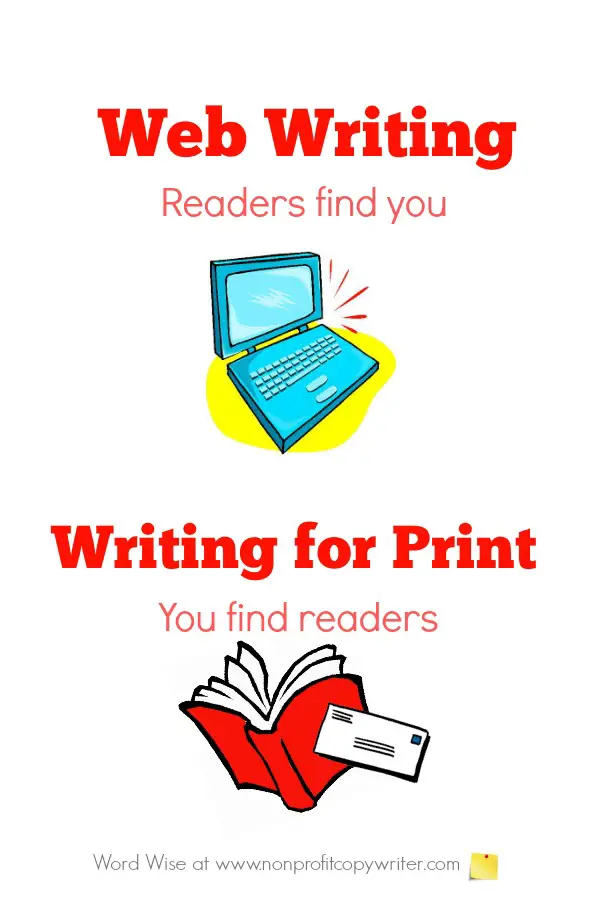
Web Writing Versus Writing for Print
Award-winning writer Kathy Widenhouse has helped hundreds of nonprofits and writers produce successful content and has gained 600K+ views for her writing tutorials. She is the author of 9 books. See more of Kathy’s content here.
Web writing and writing for print are two different mediums.
Copywriting for print leads to a tangible piece, produced on paper. Online writing, on the other hand, is delivered to a computer screen, tablet, or mobile device.
But the most significant difference is the what readers need. To be effective, you need to know what a web reader needs and what a print reader needs ... and how to structure your writing accordingly.
Readers Find You Different Ways Online and in Print
Your print piece seeks out the reader in his mailbox, bookshelf, or magazine.
An online reader, on the other hand, has come looking for your website or your post. Your writing provides him what he is seeking.
Which leads us to the foundational principle you need to know about the difference between writing for print and writing for the web …
Print copywriting works to hook a reader (and then convince him to keep reading.) You find readers.
Web copywriting provides information that readers are already looking for. Readers find you.
Writing for Print Readers
When you write a print piece, the onus is on you to grab the reader’s attention from whatever was on her mind to begin with and turn it your brochure, report, magazine article, letter, or book.
Unless you provide a compelling reason to notice your print piece, Mr. or Ms. Reader will not find it.
Writing for Web Readers
Website readers, on the other hand, are on a mission. They search the web or check their inboxes, looking for information, a product, or a service. These folks are already pre-disposed to find your content. Sure, web readers have limitless options. But the fact is that they are online and they seek you out.
What A Web Reader Looks For
This subtle difference makes a big difference in how you write online.
Print content shouts, "Here is my content. Let me direct your attention away from what you're doing right now so you will read me!"
But online writing takes a different approach. Since online readers seek out information, you need to package your content with them in mind. How can you help your reader? How can you format it to meet her needs, even if you have specific content you want her to read?
Good online writing (including websites, social media posts, blogs, and eBooks) is well-optimized and written in a conversational tone.
It guides the reader to helpful information quickly, easily, and clearly – information she is looking for, written specifically for her to read online.
Do that, and your readers will read you.
More Web Content Writing Tips
Web Content Writing: A Quick Tutorial ...
How to Search for Keywords the Easy Way ...
The Skinny on Thin Content: Don’t Put Rankings Over Readers ...
Searching for Keywords? Use These SEO Writing Terms ...
Contextual Links and Why You Need Them on Your Website ...
What Is SEO Content Writing? Tips for Strong Search Results ...
Online Writing: How It Is Uniquely Constructed ...
3 Simple Tips for Writing Better Web Pages ...
The Inverted Pyramid: Article Writing Format for Online Content, Too ...
The Top Online Copywriting Tip ...
How Keywords Work: an overview ...
Keyword Glossary: Quick SEO Jargon at Your Fingertips ...
Long Tail Keywords: A Quick Guide to Using Unpopular Search Terms ...
6 places to use keywords in web pages and blog posts ...
3 Tips for Writing Conversationally Online (and Off) ...
The Best Word Count for SEO ...
Conversational Copywriting: online writing course ...
Review: Conversational Copywriting - an Online Writing Course ...
More Online Writing Tips on our Pinterest board ...
Return from Web Writing vs. Writing for Print to Nonprofit Copywriter home
As an Amazon Associate I earn from qualifying purchases.
Search This Site
Share This Page

Named to 2022 Writer's Digest list
BEST GENRE/NICHE WRITING WEBSITE


Stop Wasting Time!

Grab your exclusive FREE guide, "5 Simple Writing Tips You Can Put to Use in 10 Minutes or Less"









